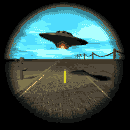Video Source: JoetheElectrician
A pair of NASA spacecraft smashed into the moon at twice the speed of a bullet, as part of a mission aimed at blasting up signs of water ice.
Pictures of the impact zone were beamed back live to Earth, but the video imagery did not show any signs of a flash.
"It's hard to tell what we saw there," said Michael Bicay, director of science at NASA's Ames Research Center in California.
The first crash took place at 7:31 a.m. ET. That’s when an empty rocket that weighed 2.2 tons hit the crater Cabeus. It was expected to create a crater about 66 feet (20 meters) wide, which is half the length of an Olympic pool. The blast should have kicked up a plume of lunar debris about six miles (10 kilometers) high.
Scientists hoped an analysis of the debris would confirm the theory that water — a key resource if people are going to go back to the moon — is hidden below the barren moonscape.
Trailing behind the rocket was the lunar probe LCROSS, short for Lunar Crater Observation and Sensing Satellite and pronounced L-Cross. For four minutes, the LCROSS shepherding spacecraft sent Earth live pictures of the rocket stage's expected impact zone in multiple wavelengths — and then plunged into the crater itself.
Telescopes focus on crash siteTelescopes around the world — including the orbiting Hubble Space Telescope — aimed their cameras at the moon to capture views of the dust-up.
At least one telescope team, at the MMT Observatory in Arizona, reported spotting a bright debris plume. The visible-light images sent back by LCROSS itself showed no sign of such a plume, although Bicay noted that evidence of a crash did turn up in thermal imagery.
LCROSS project manager Dan Andrews said it was possible that the lighting was bad for the spacecraft's images, and that those images needed to be tweaked to make the debris plume easier to see. The raw images could have been essentially “gray against black,” he said.
“What matters for us is: What is the nature of the stuff that was kicked up going in?” Andrews said. “All nine instruments were working fine and we received good data.”
The data will be analyzed for weeks to come. If the analysis shows no signs of water, that would run counter to recent findings suggesting that lunar soil, also known as regolith, contains more water ice than previously thought.
However, Bicay said there could be other explanations for the absence of a water signal. For example, it may be that the water is unevenly distributed — even within the permanently shadowed polar craters that are thought to be the best prospects for ice mining. Bicay said LCROSS' scientists may have come across a situation familiar to Texas oil wildcatters.
"We may have hit a dry hole rather than a wet hole," he said.
Mission ends after mere monthsLaunched in LCROSS and its bigger rocket stage launched together last June and only separated Thursday night, the last major milestone before the big crash.
The lunar demolition derby was broadcast live on NASA Television and on the Internet. NASA reported that as many as 391,000 Internet users were watching the webcast concurrently. That made it the space agency's third biggest Web video event, behind the space shuttle Discovery's launch and landing in 2005.
Click for related content
Three probes confirm water’s presence on moonOrbiter sees tentative signs of water on moonSave the moon? Experts try to ease fears
Museums and observatories across the country hosted early-morning LCROSS gatherings, but in most cases, the events didn't live up to advance expectations. At Los Angeles' Griffith Observatory, people who got up early to look for the crash threw confused looks at each other instead.
Telescope demonstrator Jim Mahon called the celestial show "anticlimactic.”
“I was hoping we’d see a flash or a flare,” he said.
The LCROSS probe cost $79 million and was an add-on to a bigger NASA satellite, known as Lunar Reconnaissance Orbiter, which is now circling the moon.
Source: msnbc














No comments:
Post a Comment